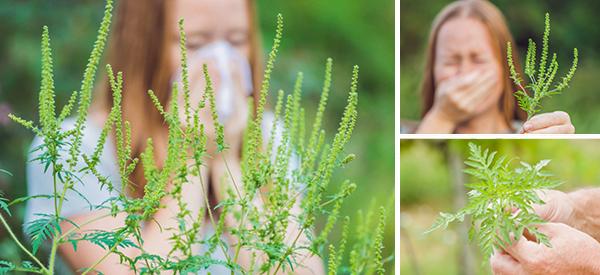
If You See This Weed Growing In Your Yard, Don’t Smell It – Here’s Why
Seasonal allergies affect millions of Americans. One of the worst culprits is ragweed. More than 23 million Americans suffer from a ragweed allergy, making it one of the most common weed allergies. These allergies can cause a runny nose, itchy watery eyes, and aggravate asthma.
About Ragweed
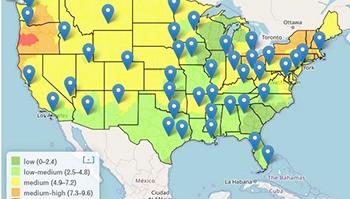 There are 17 different species of ragweed and they are found in 49 US states, only Alaska is lucky enough to avoid it. Ragweed is a member of the genus Ambrosia and in the aster family, Asteraceae. While there are many species of ragweed, the species we encounter most often are common ragweed, Ambrosia artemisiifolia, and giant ragweed, Ambrosia trifida.
There are 17 different species of ragweed and they are found in 49 US states, only Alaska is lucky enough to avoid it. Ragweed is a member of the genus Ambrosia and in the aster family, Asteraceae. While there are many species of ragweed, the species we encounter most often are common ragweed, Ambrosia artemisiifolia, and giant ragweed, Ambrosia trifida.
How to Identify It
Common ragweed begins to sprout in early June. It is best to try and eliminate it from your garden before it begins to flower and release pollen.
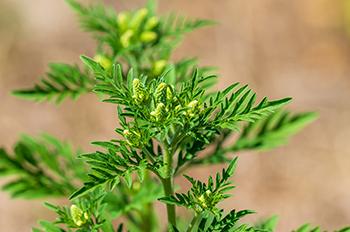 You can identify it by its distinctive leaves. The leaves are fern-like and often hairy. A bushy plant produces both male and female flowers. Neither are particularly showy, being small and green. The male flowers are more obvious, appearing at a spike on the top of the plant. The female flowers are more hidden, located between the leaves, close to the stem. The plant generally reaches six feet in height.
You can identify it by its distinctive leaves. The leaves are fern-like and often hairy. A bushy plant produces both male and female flowers. Neither are particularly showy, being small and green. The male flowers are more obvious, appearing at a spike on the top of the plant. The female flowers are more hidden, located between the leaves, close to the stem. The plant generally reaches six feet in height.
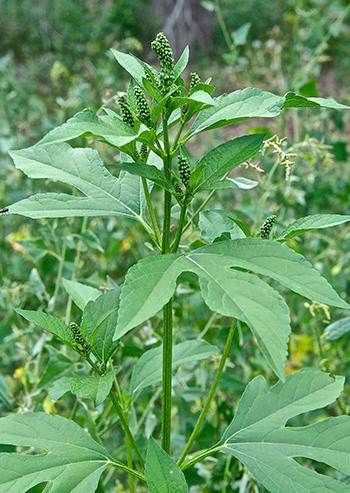
Giant ragweed is much larger. Giant ragweed differs from common ragweed in more than just size, though it is called giant for a reason.
Giant ragweed can reach heights of sixteen feet. The other main difference between these two species is their leaf formation. While the leaves of common ragweed are fern-like, the leaves of giant ragweed are palmate, meaning they resemble the palm of your hand. They often have five segments, though other leaves will only have three segments. These leaves are quite large, up to a foot in length, with serrated edges, and hairy undersides. The flowers on giant ragweed are quite similar to common ragweed and both plants produce copious amounts of pollen.
Ragweed Lookalikes
Ragweed can be easily confused with other plants. It is most often confused with either goldenrod or mugwort. Goldenrod particularly is often blamed for seasonal allergies because it features showy yellow flowers and is similar in appearance to ragweed. Mugwort also resembles ragweed, as it belongs to the same family. Mugwort however doesn’t feature the same allergy-inducing compounds.
The Ragweed Pollen
The primary problem people have with ragweed is its pollen. So while you certainly don’t want to stop and smell the ragweed, avoiding smelling it, unfortunately, isn’t enough to prevent your allergies. Ragweed pollen is very light and is easily dispersed by the wind. It can travel great distances, hundreds of miles, so even if ragweed isn’t growing in your garden you can still suffer from its effects.
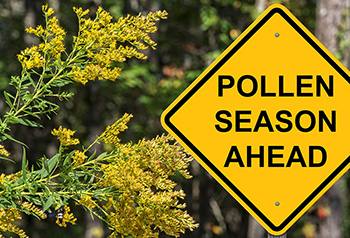
Ragweed pollen season can begin as early as July in the southern US but it usually peaks in most places from late August until mid-September. During these months if you have a ragweed allergy you can expect to suffer more. The plants begin to release pollen in the morning but peak pollen production occurs at midday, so these hours can be particularly problematic.
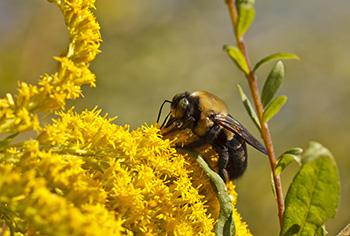
You can help alleviate some of your symptoms by remembering to change your clothes after spending time outside in ragweed season and shampooing your hair every night to make sure you don’t bring pollen into your bed.
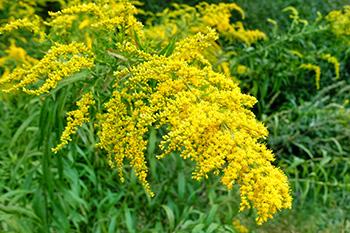
If you suffer from a ragweed allergy you are more likely to be sensitive to certain other plants in the same family. While butterbur, Petasites hybridus, is an herb commonly used to treat seasonal allergies with great effect, it should be avoided by people who are allergic to ragweed. As should chamomile, which is in the same family as ragweed. But those aren’t the only plants to avoid. You should also avoid cucumbers, melon, sunflower seeds, and bananas.
Ragweed – Medicinal Benefits
Despite all the problems, ragweed can cause it is not totally without benefits. While it is not commonly found in the modern apothecary, ragweed was used by Native Americans in many traditional remedies. In fact, ragweed has been used to treat allergy symptoms, though if you have a ragweed allergy you should be cautious using this plant. It is also used to reduce fever and help with nausea, menstrual problems, and as a laxative.
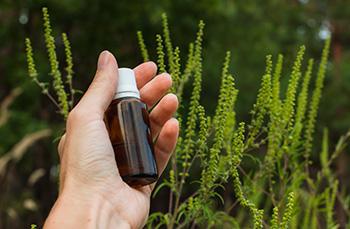
It is astringent and antiseptic so it can be used with good effect externally. Apply it topically to treat insect bites, rashes, and irritation from poison ivy. Simply squeeze leaves to release the juices inside. Then rub the juice into the affected area on your skin. You should begin to feel immediate relief. A tea can also be made from the leaves and applied topically to treat swelling.
While nothing is without benefits, overall ragweed is not a plant you want growing in your garden. Beyond the allergenic properties of the plant, it also has a bitter, medicinal smell and can impart a bitter flavor to things grown close by. If ragweed finds its way into a wheat field, the wheat will be bitter. Similarly, farmers learn to keep their dairy cows from eating this weed because of its impact on the milk’s flavor. Cows that have been grazing on ragweed produce bitter milk.
So definitely if you find ragweed growing in your garden don’t smell it. You would be best served to try and remove it as quickly as possible to minimize both the risk of seasonal allergies and so it doesn’t impact the flavor of anything you may have grown close by. I certainly wouldn’t keep it around just for its medicinal properties. Though if you get stung while out weeding the ragweed, you can use those leaves to soothe the sting.
You may also like:
Avoid Spring Allergies With These 7 Natural Remedies
The Ultimate Survival Swamp Food (Video)









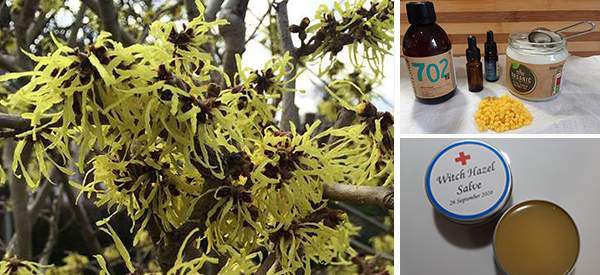
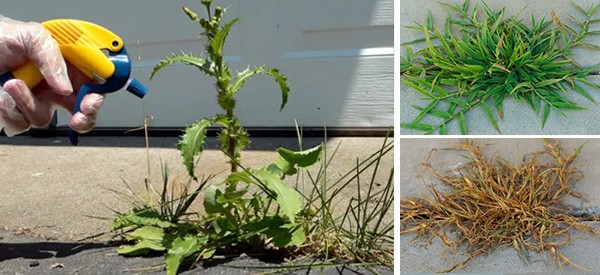
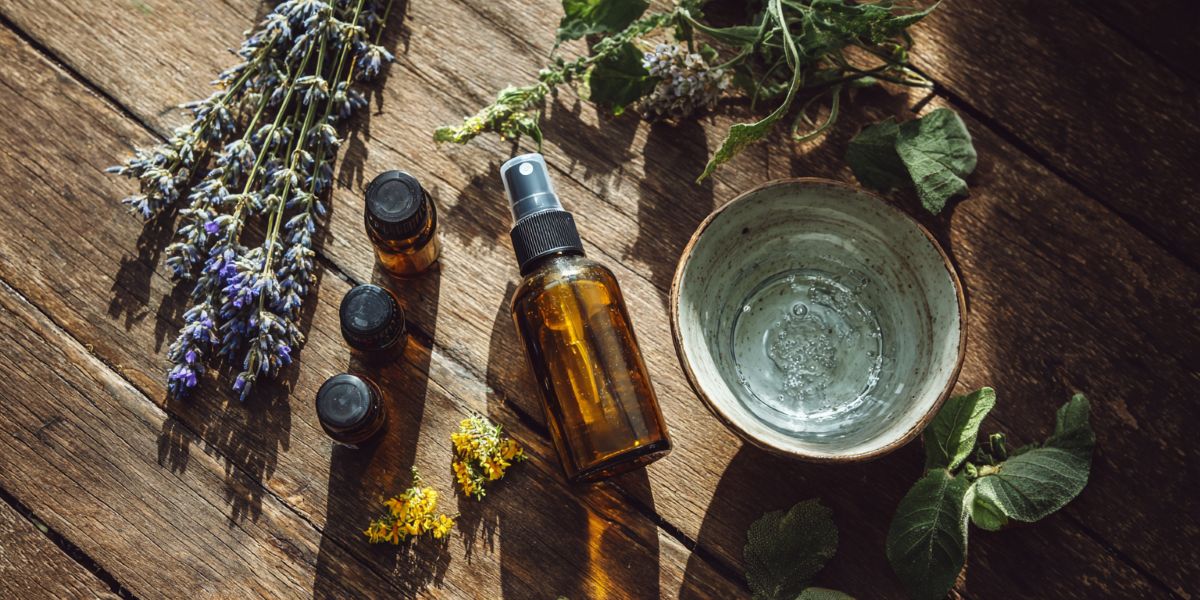
Well now I know why my allergies have been acting up lately!
you should check out The Lost Book of Herbal Remedies, they got some great allergy recipes in there
This is a question rather than a comment. Is ragweed also known as ragwort, which is dangerous to horses when dried, and when pulling it out can cause liver caoanditions?
I was able to use my prepaid debit card via Paypal before to purchase your books, for I do not see Paypal today as a choice and it was a choice for the same product a couple days ago. I do not use or have credit cards. I will like to purchas the Physical and digital product of the Forager’s Guide to Wild Foods with the additional free gifts for the offer price of $37 plus shipping. Is there a reason Paypal it is not showing up again as a payment method?
Hi Cheryl,
Please check your email address. I have sent you a purchase link.
Many blessing!